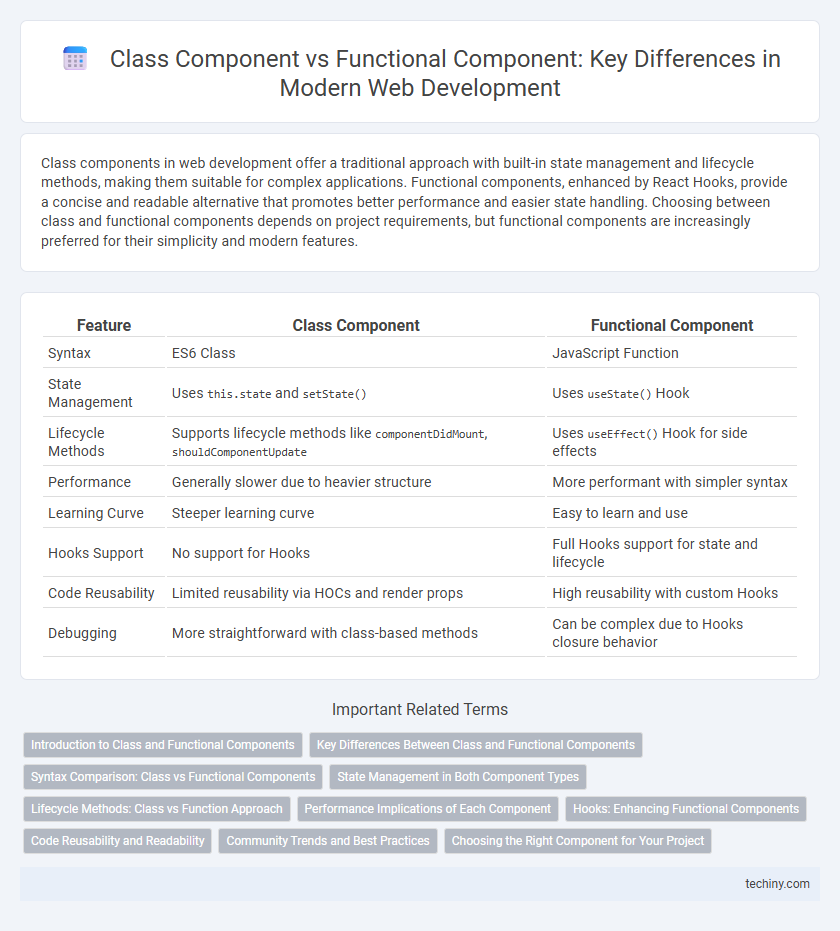Class components in web development offer a traditional approach with built-in state management and lifecycle methods, making them suitable for complex applications. Functional components, enhanced by React Hooks, provide a concise and readable alternative that promotes better performance and easier state handling. Choosing between class and functional components depends on project requirements, but functional components are increasingly preferred for their simplicity and modern features.
Table of Comparison
| Feature | Class Component | Functional Component |
|---|---|---|
| Syntax | ES6 Class | JavaScript Function |
| State Management | Uses this.state and setState() |
Uses useState() Hook |
| Lifecycle Methods | Supports lifecycle methods like componentDidMount, shouldComponentUpdate |
Uses useEffect() Hook for side effects |
| Performance | Generally slower due to heavier structure | More performant with simpler syntax |
| Learning Curve | Steeper learning curve | Easy to learn and use |
| Hooks Support | No support for Hooks | Full Hooks support for state and lifecycle |
| Code Reusability | Limited reusability via HOCs and render props | High reusability with custom Hooks |
| Debugging | More straightforward with class-based methods | Can be complex due to Hooks closure behavior |
Introduction to Class and Functional Components
Class components in web development are ES6 classes that extend React.Component and manage state and lifecycle methods within a render function. Functional components are simpler JavaScript functions that accept props and return JSX, often enhanced with React Hooks for state and side effects management. Understanding the distinction between class and functional components is essential for optimizing performance and code maintainability in React applications.
Key Differences Between Class and Functional Components
Class components in web development are ES6 classes that extend React.Component, offering state management and lifecycle methods through `this.state` and `this.setState`. Functional components, introduced as simpler JavaScript functions, leverage React hooks like `useState` and `useEffect` to manage state and side effects without class syntax or binding. Functional components are typically more concise, easier to test, and favor performance improvements due to React's optimized rendering and hooks usage compared to the heavier class components.
Syntax Comparison: Class vs Functional Components
Class components in React rely on ES6 class syntax, requiring the use of `extends React.Component`, a constructor for state initialization, and lifecycle methods like `componentDidMount`. Functional components utilize simpler JavaScript functions or arrow functions that return JSX directly, with hooks such as `useState` and `useEffect` managing state and side effects. The functional component syntax reduces boilerplate code, enhances readability, and promotes easier code reuse compared to class components.
State Management in Both Component Types
Class components in web development manage state using the built-in `this.state` object and `this.setState()` method, allowing granular control over state updates. Functional components utilize the `useState` hook from React, providing a simpler and more concise approach to state management with functional paradigms. State persistence and lifecycle methods in class components are more verbose, while hooks enable functional components to handle state and side effects efficiently in modern React applications.
Lifecycle Methods: Class vs Function Approach
Class components utilize lifecycle methods such as componentDidMount, componentDidUpdate, and componentWillUnmount to manage side effects and state changes throughout the component's lifecycle. Functional components rely on the useEffect hook to replicate these lifecycle behaviors, allowing precise control over mounting, updating, and unmounting phases in a more concise and functional style. React's shift towards hooks encourages using functional components for cleaner, more maintainable code with explicit dependencies in lifecycle management.
Performance Implications of Each Component
Class components in React often have a slight performance overhead due to their use of lifecycle methods and instance variables, which can lead to increased memory consumption. Functional components leverage hooks and avoid the complexities of class instances, resulting in faster rendering and more efficient updates through React's concurrent mode. Choosing functional components can enhance performance, especially in large-scale applications with frequent UI updates.
Hooks: Enhancing Functional Components
Hooks revolutionize functional components by enabling state management and lifecycle methods traditionally exclusive to class components, such as useState and useEffect. These hooks facilitate cleaner, more concise code with improved reusability and easier testing compared to class components. Embracing hooks drives enhanced performance and streamlined logic in modern React applications, making functional components the preferred choice for developers.
Code Reusability and Readability
Functional components in web development enhance code reusability by enabling the use of hooks, which allow logic extraction and sharing across multiple components. They generally offer better readability due to their concise syntax and clear separation of concerns compared to class components. Class components tend to be more verbose and can become cumbersome when managing complex state or lifecycle methods, reducing overall maintainability.
Community Trends and Best Practices
React's community trends increasingly favor functional components due to their simplicity and compatibility with Hooks, which enable state management and lifecycle features without the complexity of class syntax. Best practices emphasize using functional components for cleaner code, easier testing, and improved performance through memoization techniques and concurrent mode support. Despite this shift, class components remain relevant in legacy codebases, but new projects prioritize functional components to leverage React's evolving ecosystem effectively.
Choosing the Right Component for Your Project
Class components offer advanced lifecycle methods and state management capabilities, making them suitable for complex, state-heavy applications. Functional components with hooks provide a more concise syntax and improved performance, ideal for projects emphasizing simplicity and maintainability. Selecting the right component depends on your project's complexity, team familiarity with React paradigms, and the specific features required.
Class Component vs Functional Component Infographic

 techiny.com
techiny.com